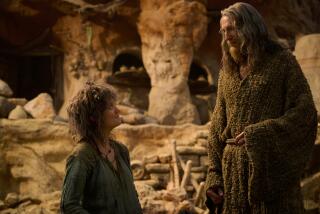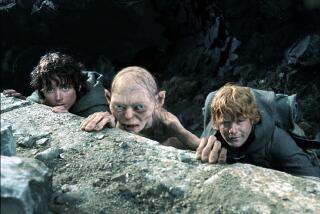Must be geek love
- Share via
When the final chapter closes on Peter Jackson’s adaptation of J.R.R. Tolkien’s “The Lord of the Rings,” the whole extravaganza -- three features, nine hours and a catalog of characters as seemingly infinite as the films’ crew -- may well be heralded as one of the more heroic ventures in commercial cinema. Launched last December to enormous success with “The Fellowship of the Ring,” the ongoing epic has now entered an awkward adolescence with its middle feature, “The Two Towers,” on its way to its concluding volume, “The Return of the King.” Slated for completion next year, the entirety of the “Rings” looks auspicious even if in its present manifestation this once and future landmark is a bit of a yawn.
Based on the second volume of Tolkien’s novel, “The Two Towers” begins fairly soon after “The Fellowship of the Ring” leaves off with the hobbits, Frodo (Elijah Wood) and Samwise (Sean Astin), warily traveling toward the Dark Tower of Mordor, the lair of Sauron the Great. Conquered in an ancient war, Sauron has been gathering his forces with the intention of obliterating the world of men, Middle-earth, for which he needs the ring. In the first film, Frodo had become the ring’s reluctant keeper, charged with its destruction by the wizard Gandalf (Ian McKellen), a mission that transported him out of the idyll of his homeland, the Shire, and into a fellowship with eight other Middle-earth inhabitants. Splintered at the close of the first volume, the fellowship has now scattered to fight its enemies separately.
“The Lord of the Rings,” built on a bedrock of mythic archetypes and sagas such as “Beowulf,” is essentially a quest story but one in which the seeker aims to renounce power, rather than to seize it. That makes Frodo uncharacteristically humble for a hero and an unusually appealing seeker no matter what the troubled times, and it also speaks to why the book was a cult favorite during the 1960s. (The hobbits’ fondness for smoking an herb called pipe-weed likely appealed to the book’s original counterculture fan base, as well.) Although Frodo hails from the pastoral Shire and is by nature and inclination gentle, each step of his journey brings him closer to cataclysmic warfare that rumbles during the first volume, erupts in the second and rages throughout the third.
Tolkien began writing “The Lord of the Rings” in 1936 and for years after its publication insisted that it had nothing to do with the Second World War. Jackson has no such qualms but his inspiration is cinematic not political. In “The Two Towers,” he cribs an iconic image of massed troops from Leni Riefenstahl’s propaganda reverie, “Triumph of the Will,” but the allusion loses its punch when you realize that another shot of goose-stepping troops has been lifted from “The Wizard of Oz.” Tolkien built his story on foundation myths; Jackson builds his on movies: The film’s most charming new creature, a mossy shepherd named Treebeard, walks like the heron described by Tolkien but looks like a relation of the animated trees in “Oz.” When Gollum (voiced by Andy Serkis, with goggling computer-generated eyes and slithering silvery body) returns to the scene to pull the word “master” from its mouth, it’s with the same sinister fawning as Dracula’s helper Renfield.
Despite these cinephile fillips, Jackson and fellow screenwriters Fran Walsh, Philippa Boyens and Stephen Sinclair have enough to do just keeping Tolkien’s histories and characters in play. To that end, the new film faithfully opens with the human warrior Aragorn (Viggo Mortensen), a huntsman with his own impending quest issues, in the company of the Elf Legolas (Orlando Bloom) and the Dwarf Gimli (John Rhys-Davies). Together, the three are hotfooting across green slopes in search of two other fellowship members, the hobbits Merry (Dominic Monaghan) and Pippin (Billy Boyd), who have been kidnapped by Orcs, servants of Sauron’s strongest ally, the wizard Saruman (Christopher Lee).
Tolkien devotes the first half of “The Two Towers” to Aragorn’s exploits and the second to those of Frodo; Jackson instead oscillates between the questing travelers before getting swept up in a battle that nearly proves the undoing of Aragorn and the film. While searching for the hobbits, Aragorn and his companions enter the human kingdom of Rohan, where they’re soon engaged in protecting its people from Sauron’s army. Jackson spends an interminable amount of time in Rohan, lavishing his attention on a battle that consumes less than a chapter in the novel. Set at night, the fight unfolds with hordes of the enemy (“thick as marching ants,” in Tolkien’s words) descending in waves. Despite Mortensen’s energetic vaults across the set, the tension slackens precipitously. It isn’t only that there’s no fun to be had watching ants get squashed; it’s that the battle, designed for the video-game generation, proceeds in frustrating starts and stops, as if Jackson couldn’t get past the first level.
With “The Fellowship of the Ring,” Jackson delivered us into never-before-seen worlds. The fellowship covers new ground in “The Two Towers” but the story bogs down in Rohan, a dreary stopover that fails to capture the imagination; unlike the Shire or Elvish lands, it doesn’t look that different from the back-lot Middle Ages we’ve seen elsewhere. During the past few decades, computer technologies have enhanced (and waylaid) numerous films but it wasn’t until Jackson’s first try at Tolkien that we saw the greater possibilities of those technologies, particularly in the realm of fantasy, where now everything seems possible. After years of anemic space escapades in which the blue screen was invariably more important than the flesh-and-blood actors, digital video technologies were put in the service of a juicy story and not the reverse.
That more or less holds true in “The Two Towers” even if for stretches at a time the tools at Jackson’s disposal distract him from what he does best, which is push the story forward with the enthusiasm of a filmmaker who hasn’t put ego before movie love. The director’s great strength is the confidence with which he translates Tolkien’s vision into visual imagery even if he still gets tripped up converting that vision into dialogue.
“The Fellowship of the Ring” was periodically hampered by the writers’ attempts to cut swaths through the narration. There’s as much exposition in “The Two Towers” but because Jackson and his screenwriter partners don’t want to repeat themselves, they lay out the story even less clearly than they did on their first outing. When Aragorn consults with Gandalf, it’s easy to get lost in a thicket of names and allegiances.
It was during one such eyelid-drooping moment while watching “The Two Towers” that I flashed on an old Gary Larson cartoon that pokes gentle fun at the nomenclature found in books of this sort by contrasting the names we give dogs with those they give themselves. “I am known as Vexog,” says one dog (a.k.a. Rex), “Destroyer of Cats and Devourer of Chickens.” “I am Zornorph,” says another, proudly, “the One Who Comes by Night to the Neighbor’s Yard, and this is Princess Sheewana, Barker of Great Annoyance and Daughter of Queen La, Stainer of Persian Rugs.”
The absurdity of the dog names was a relief, giving me a momentary reprieve from the film and its insistent monumentality. At that instant, I stopped bumming about the second film and began looking forward to the third. Such is the nature of geek love. As with “The Fellowship of the Ring,” the excitement and pleasure of “The Two Towers” comes from the feeling that we’re doing more than simply watching a film but have, rather, embarked on an epic journey with like-minded travelers. If the second film never reaches the highs of the first -- we have met the players before and there are no new worlds of wonder -- it nonetheless invests moviegoing with a sense of adventure. Like Frodo and Aragorn, we have to cover a lot of middling expository ground in “The Two Towers” -- here, we’re just passing through on our way to the end.
*
‘The Lord of
the Rings: The Two Towers’:
MPAA rating: PG-13 for battle sequences and scary images.
Times guidelines: There’s a lot of fighting and death but little bloodshed; overall, it’s less scary than the first film.
Elijah Wood...Frodo
Ian McKellen...Gandalf
Liv Tyler...Arwen
Viggo Mortensen...Aragorn
Sean Astin...Sam
New Line Cinema presents a Wingnut production. Director Peter Jackson. Writers Fran Walsh, Philippa Boyens, Stephen Sinclair, Peter Jackson. Producers Barrie M. Osborne, Fran Walsh, Peter Jackson. Director of photography Andrew Lesnie. Production designer Grant Major. Film Editor Michael Horton. Music Howard Shore. Visual effects supervisor Jim Rygiel. Special makeup creature miniature and digital effects Weta Ltd., NZ. Costume designers Ngila Dickson, Richard Tyler. Running time: 2 hours, 59 minutes.
In general release.


